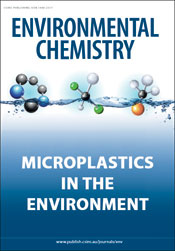
Environmental Chemistry
Volume 12 Number 5 2015
Microplastics in the Environment
EN15012Questions of size and numbers in environmental research on microplastics: methodological and conceptual aspects
Environmental context. Microplastics, either purposefully manufactured or formed by fragmentation of discarded ‘end-of-life’ macroplastic items, are accumulating in environmental compartments. As more and more data are collected on microplastics in the environment, discussion of two issues has become indispensable: (i) how reliable are the results in terms of the inherent capabilities and limitations of current methods used for sampling, counting and measuring microplastic particles; and (ii) how can the fate of microplastics be understood in the context of natural particles and colloids?
EN15012 Abstract | EN15012 Full Text | EN15012PDF (376 KB) | EN15012Supplementary Material (1.3 MB) Open Access Article
EN14172Beyond the ocean: contamination of freshwater ecosystems with (micro-)plastic particles
Environmental context. Microplastics in freshwater ecosystems are an increasingly important environmental issue, with the few available studies suggesting high contamination worldwide. Reliable data on concentrations, fluxes and polymer types in continental aquatic environments, including urban water systems, are needed. High environmental and ecological risk polymers and associated or adsorbed chemicals have to be identified, as well as their effects on both organisms and ecosystems.
EN15069Marine microplastic-associated biofilms – a review
Environmental context. Marine microbial communities, which play a crucial role in all biogeochemical processes in the oceans, could be affected by microplastic pollution. Research is necessary to understand the interactions between marine microbial communities and microplastics, and to explore the potential for microplastics to serve as transport systems for pathogenic microorganisms. Our review summarises first insights into these topics and discusses gaps in our current knowledge.
EN14205Focal plane array detector-based micro-Fourier-transform infrared imaging for the analysis of microplastics in environmental samples
Environmental context. Microplastics are of increasing environmental concern following reports that they occur worldwide from the arctic to the deep sea. However, a reliable methodology that facilitates an automated measurement of abundance and identity of microplastics is still lacking. We present an analytical protocol that applies focal plane array-based infrared imaging of microplastics enriched on membrane filters applicable to investigations of microplastic pollution of the environment.
EN14205 Abstract | EN14205 Full Text | EN14205PDF (2.1 MB) Open Access Article
EN14218Plastic pollution in Swiss surface waters: nature and concentrations, interaction with pollutants
Environmental context. Plastic, and particularly microplastic, pollution is a growing environmental concern worldwide. Research regarding marine environments has led to a substantial increase in knowledge, yet little is known as regards the situation in freshwater environments. Although the occurrence of microplastics was demonstrated in Lake Geneva in 2012, the present research aims at confirming this pollution and expanding the data set for other lakes and environments of Switzerland.
EN14167Microplastic contamination in an urban area: a case study in Greater Paris
Environmental context. Plastics production has increased considerably in the last years, leading to pollution by plastics, including microplastics (comprising particles smaller than 5 mm). This work addresses the issue of microplastics from urban sources in Greater Paris and its effect on receiving waters. Microplastics were found in all urban compartments investigated, namely atmospheric fallout, waste- and treated water, and surface water.
EN14143Adsorption of trace metals by microplastic pellets in fresh water
Environmental context. Although microplastics are known to adsorb and transport contaminants in the aquatic environment, there is no information on the significance of the effect in fresh waters. We studied the adsorption of metals to new and aged plastic pellets in river water, and show interactions that are dependent on time, pH and metal concentration. Because metals have a higher affinity for aged pellets than for new pellets, weathered microplastics could represent a significant vehicle for the transport of metals in aquatic environments.
EN14236Characterisation of microplastics and toxic chemicals extracted from microplastic samples from the North Pacific Gyre
Environmental context. Microplastics are a new source of toxic compounds in marine and freshwater environments. This research documents the discovery of microplastic fibres in the seawater column and the chemical analysis of associated toxic chemicals in microplastic marine debris. Microplastic pollution is pervasive and hazardous.
EN14234Occurrence, relative abundance and spatial distribution of microplastics and zooplankton NW of Sardinia in the Pelagos Sanctuary Protected Area, Mediterranean Sea
Environmental context. Plastic materials are accumulating in the marine environment where they can now be found in the remotest areas of the world's oceans. Microplastics (plastic particles ≤5 mm), abundant in marine surface waters, are also found in neritic and pelagic waters of Mediterranean marine protected areas. Microplastics can accumulate along marine food chains, having noxious effects on marine organisms at different trophic levels and creating a serious threat to marine ecosystems.



